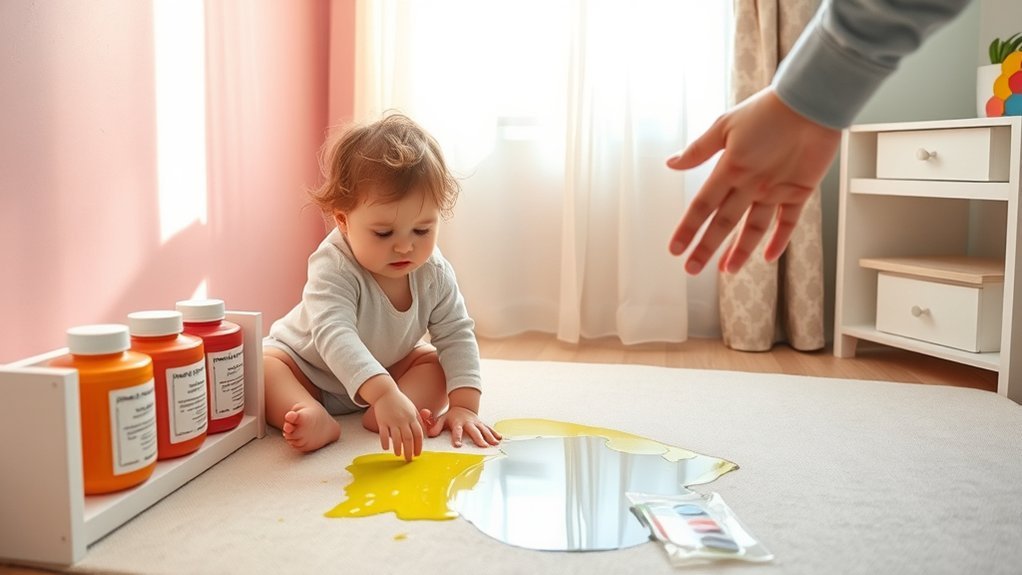When it comes to painting your nursery, safety is paramount. You need to be aware of the risks associated with paint exposure, especially for your little one. If your child shows signs like coughing, skin rashes, or unexplained headaches after you’ve been painting, it’s essential to know when to seek medical help. Understanding these symptoms can make all the difference in keeping your child safe. So, what should you look for?
Understanding Paint Ingredients and Their Risks
When you choose paint for your nursery, it’s important to understand the ingredients and their potential risks.
Many paints contain volatile organic compounds (VOCs), which can evaporate into the air and pose health effects for your little one. These compounds can irritate the respiratory system and may lead to long-term health issues.
As a parent, it’s crucial to prioritize your child’s well-being. Opt for low-VOC or zero-VOC paints, which are safer and still provide vibrant colors. Always read labels to guarantee you’re making informed choices.
Signs of Paint Exposure in Children
While creating a safe and welcoming nursery, it’s essential to recognize the signs of paint exposure in children. Being aware of these symptoms can aid in effective exposure prevention. Here’s a symptoms checklist to help you identify potential issues:
| Symptoms | What to Watch For |
|---|---|
| Respiratory Issues | Coughing, wheezing, or difficulty breathing |
| Skin Reactions | Rashes, redness, or itching |
| Neurological Signs | Headaches, dizziness, or confusion |
If your child displays any of these symptoms after painting, consult a doctor immediately. Remember, early detection is key to ensuring their well-being. Stay vigilant, and prioritize your child’s safety in their nursery environment.
Safe Painting Practices for the Nursery
To guarantee a safe environment for your child, it’s essential to adopt safe painting practices in the nursery.
Start by choosing non-toxic, low-VOC (volatile organic compounds) paints to minimize harmful emissions.
Before you begin, verify proper nursery preparation by moving your child to another room and ventilating well; open windows and use fans to circulate air.
Wear gloves and masks to protect yourself from fumes and skin contact.
Avoid painting during naptime to verify your child isn’t exposed to any lingering odors.
Always follow the manufacturer’s instructions for application and drying times.
What to Do If Your Child Is Exposed to Paint
If your child has been exposed to paint, it’s essential to act quickly and calmly. First, verify their safety and assess the situation. Here’s what you should do:
- Remove any paint from their skin using soap and water immediately.
- If they’ve ingested paint, call Poison Control or your healthcare provider for guidance.
- Monitor for any unusual symptoms, like difficulty breathing or skin irritation, and seek medical attention if needed.
These steps are critical for emergency response and maintaining health precautions.
Remember, staying composed helps your child feel secure during this distressing time.
Always keep paint products out of reach to prevent future incidents. Your proactive approach can make a significant difference in your child’s well-being.
Choosing Non-Toxic Paint Options for Your Nursery
How can you guarantee a safe and healthy environment for your little one when choosing paint for their nursery? Start by exploring eco-friendly paints that prioritize your child’s well-being.
Look for brands that specifically label their products as low VOC options, which reduces harmful emissions and guarantees cleaner air in your home. These paints aren’t only better for the environment but also minimize health risks for your baby.
When selecting colors, consider using water-based paints, as they typically contain fewer toxic chemicals. Always read labels carefully and choose trusted manufacturers committed to safety.
Frequently Asked Questions
Can Paint Fumes Affect Pregnant Women?
Yes, paint fumes can affect pregnant women, especially with certain paint types. Fume exposure may lead to headaches or nausea. It’s best to avoid painting during pregnancy or guarantee proper ventilation to minimize risks.
How Long Should I Ventilate the Nursery After Painting?
You should ventilate the nursery for at least 2-3 days after painting. This helps dissipate fumes as paint dries. Regularly check air quality; maintaining fresh airflow guarantees a safer environment for everyone.
What Are the Symptoms of Paint Poisoning?
If your child suddenly feels dizzy after you painted their room, it could be paint toxicity. Symptoms include headaches, nausea, and respiratory issues. Monitor for exposure effects and consult a doctor if they worsen.
Is It Safe to Paint While My Child Is at Home?
No, it’s not safe to paint while your child’s at home. Prioritize child safety by taking painting precautions, like ventilating the area and ensuring your child’s elsewhere, to avoid exposure to fumes and hazards.
Can I Use Old Paint in the Nursery?
Using old paint in the nursery isn’t recommended due to potential toxins. For your child’s safety, prioritize nursery preparation by choosing fresh, low-VOC paint that guarantees a healthy environment. Your child’s well-being deserves the best!
Conclusion
In creating a safe haven for your little one, it’s essential to stay vigilant about paint safety. If your child shows any signs of discomfort after exposure, don’t hesitate to seek medical advice—better safe than sorry. By choosing non-toxic paints and ensuring proper ventilation, you’re not just decorating a nursery; you’re nurturing a healthy environment. Remember, peace of mind comes from knowing you’ve taken every precaution to protect your child while adding a splash of color to their world.
